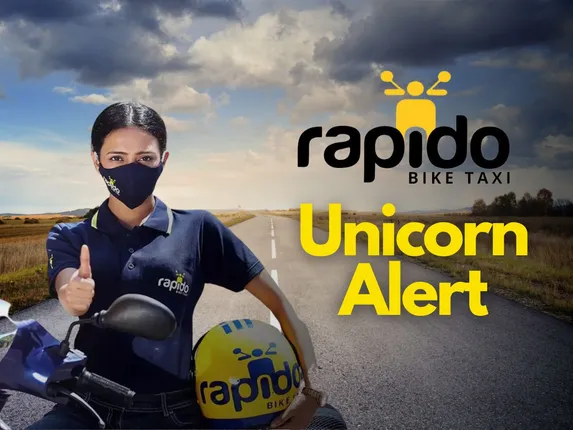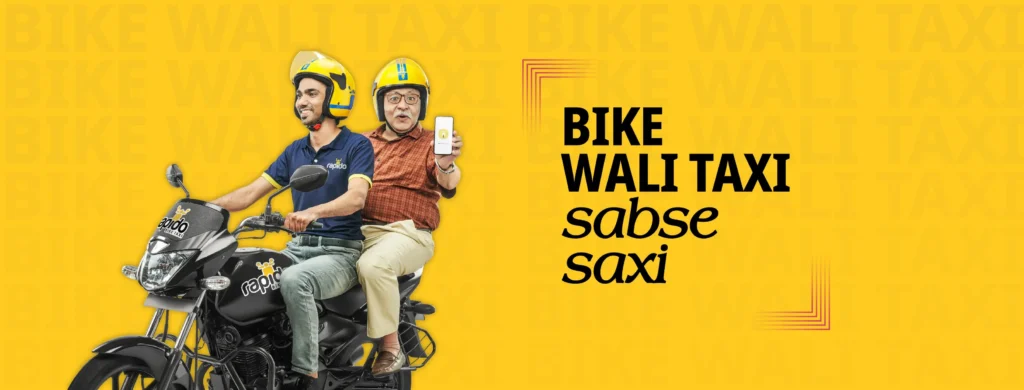
Rapido, an Indian bike taxi aggregator founded in 2015, has revolutionized the transportation sector by addressing the unique needs of the Indian middle class. With a focus on affordability, convenience, and hyperlocal connectivity, Rapido has outpaced established giants like Ola and Uber in the bike taxi space. This case study explores Rapido’s journey, strategies, and business lessons.
The Origin of Rapido
Founding Story
Rapido was founded in 2015 by Aravind Sanka, Pavan Guntupalli, and Rishikesh SR. Initially running a logistics company called “The Carrier,” they pivoted to bike taxi services after realizing the scalability constraints of their B2B logistics model. Their vision was simple: provide affordable, fast, and last-mile connectivity for Indian commuters.
Market Insight
- India’s Two-Wheeler Dominance: With over 75% of vehicles in India being two-wheelers as of 2020, the founders saw an untapped opportunity in offering bike taxis, which were more practical and economical for Indian roads.
- Affordability: Two-wheelers cost less to purchase, maintain, and operate compared to cars, making them ideal for low-income and middle-class consumers.

Business Model and Key Strategies
Business Model
Rapido’s platform connects bike owners (called “Captains”) with passengers via its mobile app. Unlike competitors Ola and Uber, which focused on four-wheelers, Rapido zeroed in on two-wheelers to carve out a niche.
- Revenue Model: Captains pay Rapido a commission per ride (~15%) or a flat subscription fee.
- Customer Proposition: Affordable rides starting at ₹10 per kilometer, with an emphasis on short distances.
Key Strategies
1. Tier-2 and Tier-3 City Expansion
- Rapido prioritized smaller cities where Ola and Uber had limited presence, enabling them to capture untapped markets.
- Larger cities like Bengaluru and Delhi were avoided initially to sidestep direct competition with giants.
2. Empowering Captains
- Flexible work hours and immediate payments after rides attracted bike owners.
- Captains were allowed to use the same bikes for food delivery during lean hours, ensuring consistent earnings.
3. Safety Measures
- Introduced background checks and training for Captains.
- Launched “Rapido Bike Pink” for female riders, ensuring that female passengers could ride with women Captains for added security.

Challenges and Resilience
Funding Struggles
- Rapido’s founders were rejected by 75 venture capitalists, many of whom doubted the viability of a bike taxi service in India.
- Despite setbacks, they secured investments from notable figures like Anupam Mittal (Shaadi.com), Gaurav Munjal (Unacademy), and Kunal Bahl (Snapdeal).
Legal Battles
- Faced regulatory issues in states like Tamil Nadu and Karnataka, where bike taxis were deemed illegal.
- Adapted by branding itself as a “software platform” rather than a “cab aggregator” to avoid licensing complexities.
Competition from Ola and Uber
- Both competitors launched bike taxi services but struggled due to their focus on higher-margin four-wheeler services.

Diversification and Growth
COVID-19 Adaptation
- Partnered with Swiggy to offer delivery services for Captains during the pandemic, ensuring continued revenue streams.
Auto-Rickshaw Services
- In 2020, Rapido launched auto-rickshaw rides, introducing a “zero-commission” model to attract drivers and expand its customer base.
Revenue Growth
| Year | Revenue (₹ Crores) | Growth Rate |
| 2022 | 158 | — |
| 2023 | 214 | +35% |
Business Lessons Categorized by Functions
A. Operations
- Adaptability: Rapido’s pivot from logistics to bike taxis exemplifies flexibility in responding to market demands.
- Efficiency: Lean operations with a focus on small-scale markets ensured rapid scalability.
B. Marketing
- Localized Campaigns: Targeted Tier-2 and Tier-3 cities with region-specific offers and messaging.
- Affordability Messaging: Highlighted cost savings compared to traditional taxis.
C. Finance
- Cost Optimization: Rapido minimized costs by offering low commission rates and leveraging an asset-light model.
- Strategic Partnerships: Collaborated with brands like Swiggy for additional revenue streams.
D. Technology
- User Experience: Intuitive app design with features like real-time tracking and instant Captain payments.
- Data-Driven Insights: Leveraged analytics to optimize routes, reduce costs, and improve customer experience.

Competitive Edge
| Factor | Rapido | Ola | Uber |
| Focus | Bike Taxis | Multi-Service | Multi-Service |
| Target Market | Tier-2/3 Cities | Tier-1 Cities | Tier-1 Cities |
| Captain Earnings | Flexible | Incentive-Driven | Incentive-Driven |
| Legal Positioning | Software Platform | Cab Aggregator | Cab Aggregator |
Future Prospects and Challenges
Opportunities
- Quick Commerce Partnerships: Rapido plans to collaborate with grocery delivery companies to expand its service offerings.
- Urban Mobility Revolution: Continued growth in two-wheeler adoption and government initiatives for electric mobility could benefit Rapido.
Challenges
- Regulatory Issues: Stricter transport regulations could threaten Rapido’s operations.
- Profitability Concerns: The subscription-based model limits earnings per ride.
- Competition: Ola and Uber’s renewed focus on two-wheeler services poses a risk.
1. Market Segmentation (2023)
- Tier-1 Cities: 40% of rides.
- Tier-2 Cities: 35% of rides.
- Tier-3 Cities: 25% of ridess
2. Legal and Market Expansion Timeline
- 2015: Rapido launched.
- 2018: Regulatory challenges in Tamil Nadu.
- 2020: Diversified into auto services.
Conclusion
Rapido’s journey is a testament to resilience and innovation in a competitive market. Key lessons for entrepreneurs and businesses:
- Focus on Untapped Markets: Prioritizing smaller cities created a competitive advantage.
- Adaptability: Diversifying services during crises like COVID-19 ensured continuity.
- Lean Operations: A cost-efficient, asset-light model allowed rapid scaling.
- Customer and Partner Focus: Empowering Captains and addressing commuter pain points secured long-term loyalty.
References
- Rapido Founders’ Interviews (2023)
- Market Reports on Two-Wheeler Adoption in India (2020)
Brief overview
The Rapido success story is a remarkable tale of the Indian bike taxi revolution, where a determined startup disrupted the two-wheeler taxi business and showed how Rapido beat Ola and Uber, earning its place in every notable startup case study. Founded by the visionary Rapido founders, the journey reflects immense startup resilience, starting from a strategic pivot from logistics to taxis to becoming a unicorn, all while overcoming 75 VC rejections. Rapido’s vision of providing affordable travel options and catering to the need for hyperlocal transportation solutions redefined last-mile connectivity, particularly in Tier-2 and Tier-3 cities, capitalizing on India’s two-wheeler dominance. Built on an asset-light business model, Rapido’s use of a zero-commission model, combined with real-time payment for Captains, set new benchmarks in app-based mobility solutions. Initiatives like Bike Pink (Women Safety Initiative) highlighted its innovative edge.
By understanding how Rapido outpaced Ola and Uber, the startup successfully disrupted the mobility space and focused on capturing untapped markets with its cost-effective commuting solutions, aligning with the latest smart mobility trends. During crises like COVID-19, Rapido displayed adaptability through COVID-19 adaptation strategies, including partnering with Swiggy for survival and auto-rickshaw services expansion, further boosting its position with plans for quick commerce collaborations. Despite facing significant hurdles like Rapido’s legal challenges, overcoming state bans, and addressing licensing for bike taxis, the company smartly positioned itself as a software platform vs. a cab aggregator, navigating through regulatory complexities.
The company’s meteoric rise can be attributed to Rapido growth secrets, offering valuable business lessons from Rapido, and implementing Rapido’s blueprint for success, making it India’s most innovative bike taxi startup. Looking ahead, Rapido is well-positioned for the future of bike taxis in India, ensuring it remains a critical player in the mobility ecosystem.
Leave a Reply